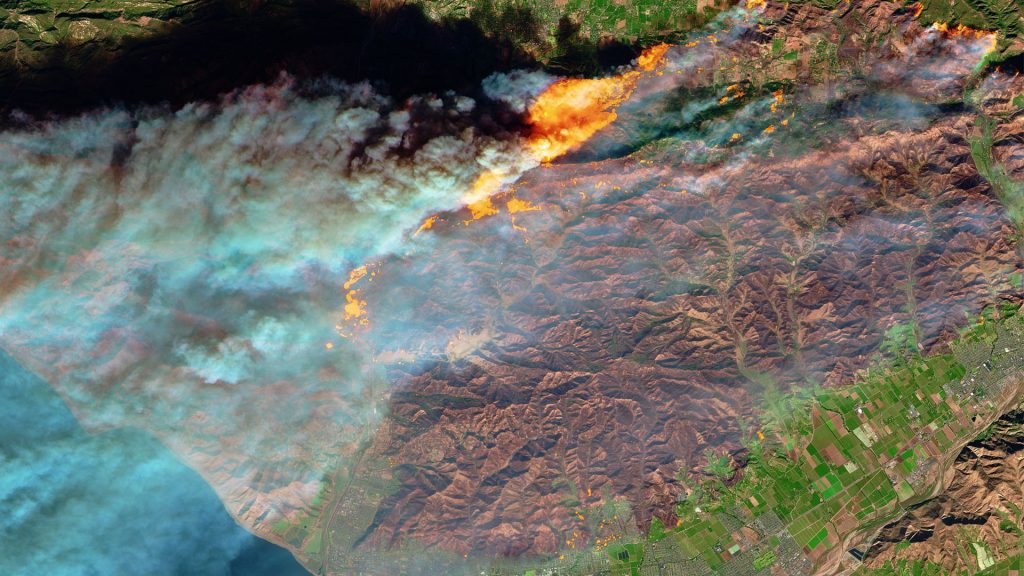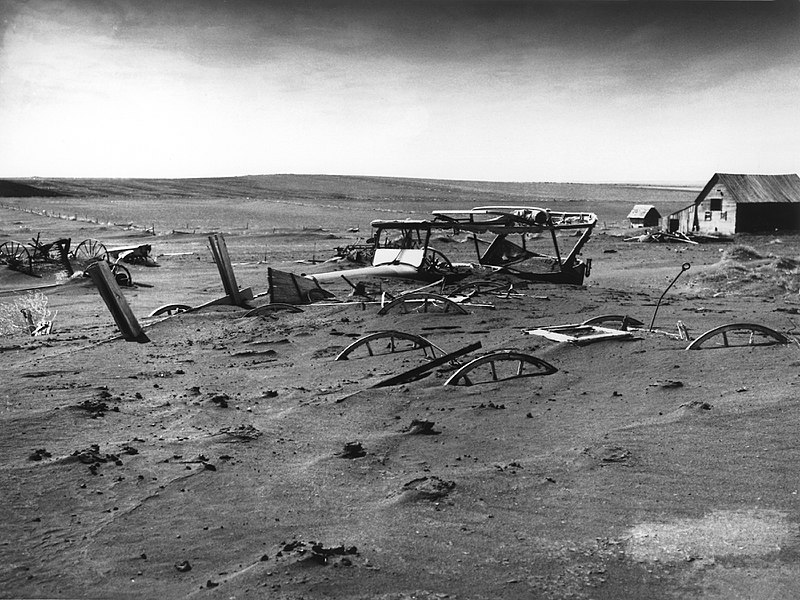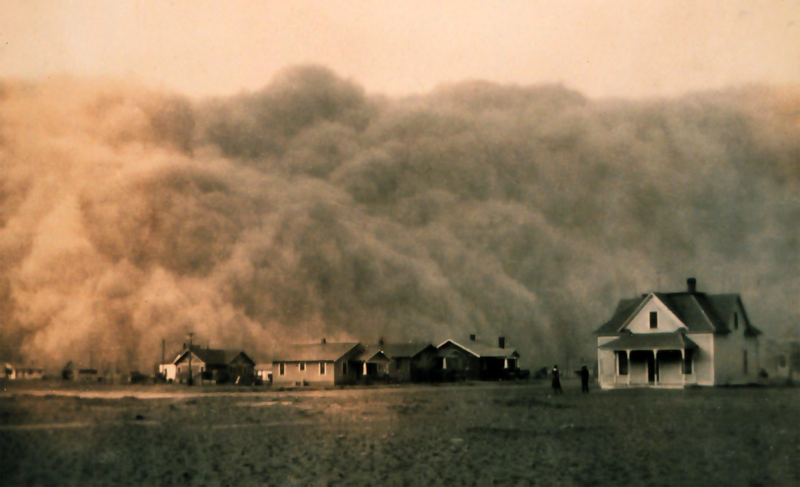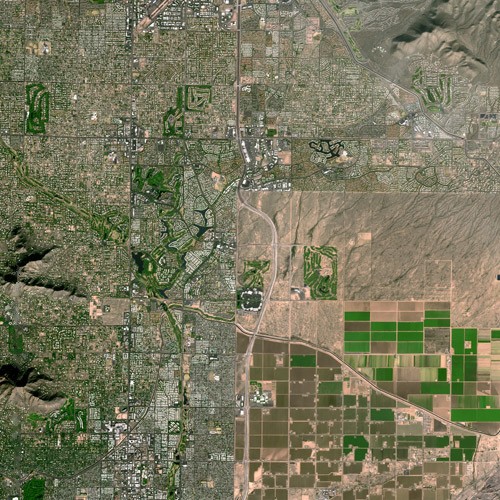My shovel hit the earth with a ka-chunk. My friend and I were digging trenches to lay down a line of asparagus. We didn’t get far. The ground on a stretch of urban territory in Washington DC consisted of a thin layer of grass covering gravel mixed with burnt-orange clay. Clay is the iconic soil of the American South. In Margaret Mitchell’s novel Gone with the Wind, Scarlett O’Hara, the man-hungry party-girl, stands in the smoking ruins of the Civil War and longs for the ‘red earth of Tara’. In the novel’s conclusion, Scarlett realizes that, more than any man, her native soil ‘was her strength’.
Silly, cruel Scarlett didn’t know that the rolling fields of raw, red earth on her father’s slave-labour plantation were just a tattered remnant. Her ancestors had pillaged the rich, black topsoil of the Georgian Piedmont, leaving only a clay subsoil. That earthly impoverishment led to others. The more Southern planters stripped their farms of nutrients, the harder they beat their slaves to produce enough cotton, sugar and tobacco to bankroll the silks and barbecues Scarlett so enjoyed.
Until a person starts digging, the depletion of the ground underfoot goes unnoticed. Yet soils spread beneath us as important historical artefacts. The search for mineral nutrients has propelled the colonization of large parts of the globe. The crises over depleted soils inspired the first proto-environmental movements in the 19th century and had a lot to do with the creation of both the social welfare state and 21st century global capitalism.
Not that I’m the first to point this out. Since the 19th century, conservationists, economists, nationalists and environmental historians have written a great deal about soil quality and the ‘rape of the land’.My experiment in trying to farm on disturbed urban territory got me thinking about how history might be changing with the molecular turn in biology. Scientists no longer think of soil as a collection of mineral elements. Molecular biologists have shown that billions of microscopic organisms dwell in healthy soils to form a superorganism of wondrous complexity. As I dug through rock and clay, I wondered how a history of this soil microbiome would read? Is it possible to populate the ground beneath my feet with the story of the tiny lives down there?
I looked under my spade. I had little to go on. There was almost nothing alive on this tuft of land on the edge of a public grade school. The site had been a staging ground for a major construction project. For two years, bulldozers, trucks and cranes had crawled back and forth, scraping and removing plants and earth, compacting and pulverizing the ground. After the renovation was complete, workers rolled out nylon landscaping nets, dumped a layer of commercial topsoil, pumped on some liquid nitrogen fertilizer and broadcast grass seed. It was good enough for a lawn but not for a vegetable garden.
Lawns are often dead zones. Shorn turf grass doesn’t feed native birds, bees, butterflies and it doesn’t sustain people in a city with high poverty and malnourishment rates in the midst of a pandemic. My friend Wesley and I wanted to see how many edible trees, shrubs and cover crops we could coax into life on the narrow banks of grass around the heavily-trafficked school. We started this project with no grand aspirations to feed the city, but just for fun and the challenge of it. Wes and I became friends while gardening on ground to which we had no claim. In a few years, we turned a trashy patch of no-man’s land into a flower-and-vegetable-filled garden that makes pedestrians slow down and look.
Making an edible forest around the grade school was a bigger project for which we had no budget, no staff –other than ourselves – and just a wee bit of permission from the school garden coordinator.

Satellite image of the Thomas Fire’s burn scar and active flames, in northern Ventura, California. Credit: NASA Earth Observatory images by Joshua Stevens, via Wikimedia Commons
A terrain of extinction
As spring warmed the ground, we began to plant. The school was mothballed so no one was around except for a pack of joyful children unleashed from classrooms, soccer practice and piano lessons. They paid us no mind as we rolled out wheel barrows and turned over the soil.
Once started, we had trouble stopping. Wes and I spaded up the fringes of the school’s community garden, setting down seeds of kale, spinach, arugula and wild flowers. We moved on to the east side to plant strawberries and asparagus. We spaded up ground for hardy berry bushes and fig trees along the school’s southern facade, which bakes as hot and dry as any Italian olive grove. We climbed the pad-locked courtyard fence to slip in native pawpaw and persimmon trees, while thumbing seeds of corn, beans and squash into the soil. These new edibles took root among struggling imported plants that the landscapers had laid down like carpet – and which are as nutritional as carpet too.
Wesley grafted fruiting apple branches onto ornamental trees and nestled tomato starts among decorative shrubs. We hoped the strawberry plants would spread as a cover crop to replace the English ivy where great clouds of mosquitoes breed. A city tree cutter gave us freshly-cut white oak logs. We inoculated them with the spawn of shitake mushrooms and stowed them in the shade of holly trees. Finally, we moved on to the marginal land on the west side of the school, where the cranes and trucks had rolled.
There, the soil had nothing to it. I dug in and lifted my spade to reveal a terrain of mass extinction. The ground held no worm, bug, root nor fungi. Nothing. As we dug, we unearthed only ‘foreign’ elements – glass, plastic, asphalt, brick and heavy, rust-iron nails. For a historian, it comes as no surprise that we live on ruins left by our predecessors, but I was in no mood for an archaeology expedition. My eye was on the future. Building soil, restoring dead ground to life during a pandemic was my route to overcoming the crushing weight of the past that is both my day job and a harsh daily reality in my neighbourhood.
Flattened ground aerates poorly and has trouble both holding water and draining it. We could see that even grass and invasive weeds had a hard time growing on the West side plot. Healthy soils are springy, lined with hair-thin roots and densely populated with a world of life in the form of insects, tiny animals, bacteria, viruses and fungi. Fungi send food and messages that zoom around the underground realm. Specialized bacteria ally with root tips, which serve as the command centre of plants. Azotobacter produces growth-stimulating chemicals. Rhizobium and Glomus work with roots to reduce disease in soils.Another bacteria, streptomyces (the same helpful bacteria in human antibiotics), rescues thirsty plants during droughts.If drought conditions continue, root bacteria can even mutate to alter their metabolism to help plants along. Other bacteria and fungi quarantine plants from insects and pests.
Buried machinery in barn lot in Dallas, South Dakota, during the Dust Bowl. Photo by United States Department of Agriculture, via Wikimedia Commons.
And then Alexander von Humboldt sneezed. Travelling in South America, the Prussian polymath noticed Peruvians unloading grey baskets of a dusty substance that made his nose twitch. He inquired and learned it was guano, the faeces of bird that had fed on fish and landed on coastal rocks to relieve themselves. Humboldt brought a scoop of guano home and chemists analysed it. The guano was rich in nitrogen, potassium and phosphate, just the nutrients that plants on famished ground hunger for. A few experiments showed that crops flourished in guano rich soils. Soon, everyone wanted it.
By mid-century, the quest for nitrogen sources led to a new round of colonization. The United States passed the Guano Islands Act in 1856. They raced Great Britain, Peru, Ecuador and Chile to poke their flag down on every rocky, bird-shit coated outcropping they could find. British leaders took hold of Namibian guano. In 1879, Peru and Bolivia went to war against Chile for access to a Chilean-owned mines of sodium nitrate, a guano substitute. The name of the disputed mineral ‘Chilean saltpeter’ tells you who won that war. But there was never enough. Farmers ran through the original supply of Peruvian guano in just a few decades. Prices for Chilean saltpeter rose.
Watching world populations multiply while soils grew exhausted, pundits predicted an approaching calamity – an intellectual fixation which historian Thomas Robertson calls ‘environmental Malthusiasm’. Agronomists fretted that degraded land reduced the earth’s ‘carrying capacity’, a term borrowed from ranchers to calculate how many animals or people a patch of ground could sustain. German thinkers worried especially. If Germany had a conflict with a superior naval power (say Great Britain), they would be cut off from Chilean nitrate imports. Germany was addicted to imported nitrates for both fertilizer and explosives. Historians often fix on historical actors that move about, vote and wage war. In this case the deficit of one tiny nitrogen molecule stood to knock over the powerful German state. For a century German scientists tried to ‘fix’ nitrogen in the air to a form they could use, a simple task which plants cooperating with microbes do reflexively.
It took a hundred years before the German chemist Fritz Haber devised a high-energy method using lots of heat and pressure to combine atmospheric nitrogen with hydrogen to form ammonia or nitric acid. The engineer Karl Bosch scaled up Haber’s invention, showing that all it took to produce ammonia were huge factories with gobs of fossil fuels – energy ancient plants had captured from the sun millennia before. Bosch drew up blueprints for the Oppau ammonia factory in 1909, the same year that one-thousand people met in Budapest for the first international conference on soil science. The attendees had no idea that the ‘Haber-Bosch’ process, an invention whose impact on human history rivals the steam engine and the splitting of the atom, would flip the ratio of nitrogen on earth from scarcity to glut.
But before that development, the unlucky convergence of the Haber-Bosch process with WWI diverted the wondrous technology from food to war. In the spring of 1915, a blockade severed Germany from Chilean nitrates just as barrels of nitric acid rolled off the line in time to make explosives. Bomb after bomb dropped on sorrowful fields of soldiers dug into mud like miserable human earthworms. Bombs packed with nitrogen lit up the soldiers’ half-buried forms and killed them like no war before.
A tsunami of nitrogen
After WWI, the soil problem intensified. A British agronomist, Gilbert Fowler, dismissed industrial nitrogen as a fertilizer. Farming was not just chemistry, he argued. Plants needed much more than a few simple molecules. After a typhoid outbreak in 1909, Milwaukee’s ‘sewer socialists’ hired Fowler to design a waste treatment facility. Fowler’s state-of-the-art plant turned Milwaukee’s sludge into nitrogen and phosphorous-rich fertilizer. Thanks to the treatment facility, human waste no longer poured into Lake Michigan, a development that saved residents from lethal illness, rescued fish from algae blooms and liberated everyone from a putrid stench. Fowler’s design could have radically changed global history by reproducing on an industrial scale ancient farm practices that recycled organic nutrients. But Fowler and Milwaukee’s sewer socialists became just a footnote. As Fowler’s waste treatment plant opened in 1925, the Haber-Bosch process made commercial nitrogen cheap, curbing the desire for recycled human waste.
Fowler went to India to learn more from Indian farmers who composted night soil effectively. His work inspired Albert Howard, an English botanist also stationed in India. Howard became the modern proponent of ‘organic farming’, a new term for old practices. His basic tenet held that farms should close the cycle of nutrients from soils to crops and back again. Some contemporaries took this idea further. The Indian botanist Jagadis Chandra Bose and the Austrian Goethe scholar Rudolf Steiner saw a ‘vital force’ in soils. Bose speculated there existed no break ‘in the life processes that characterized the animate and inanimate world’. Steiner, following the German romantic tradition, thought a farm should be treated as a living organism. Soils, like plants and animals, were alive, Steiner taught his disciples. Plants were the ‘belly on the farm’ while soil made up the diaphragm helping to move air, water and nutrients from earth to plants.
Dust storm approaching Stratford, Texas. Photo by NOAA George E. Marsh Album via Wikimedia Commons


















